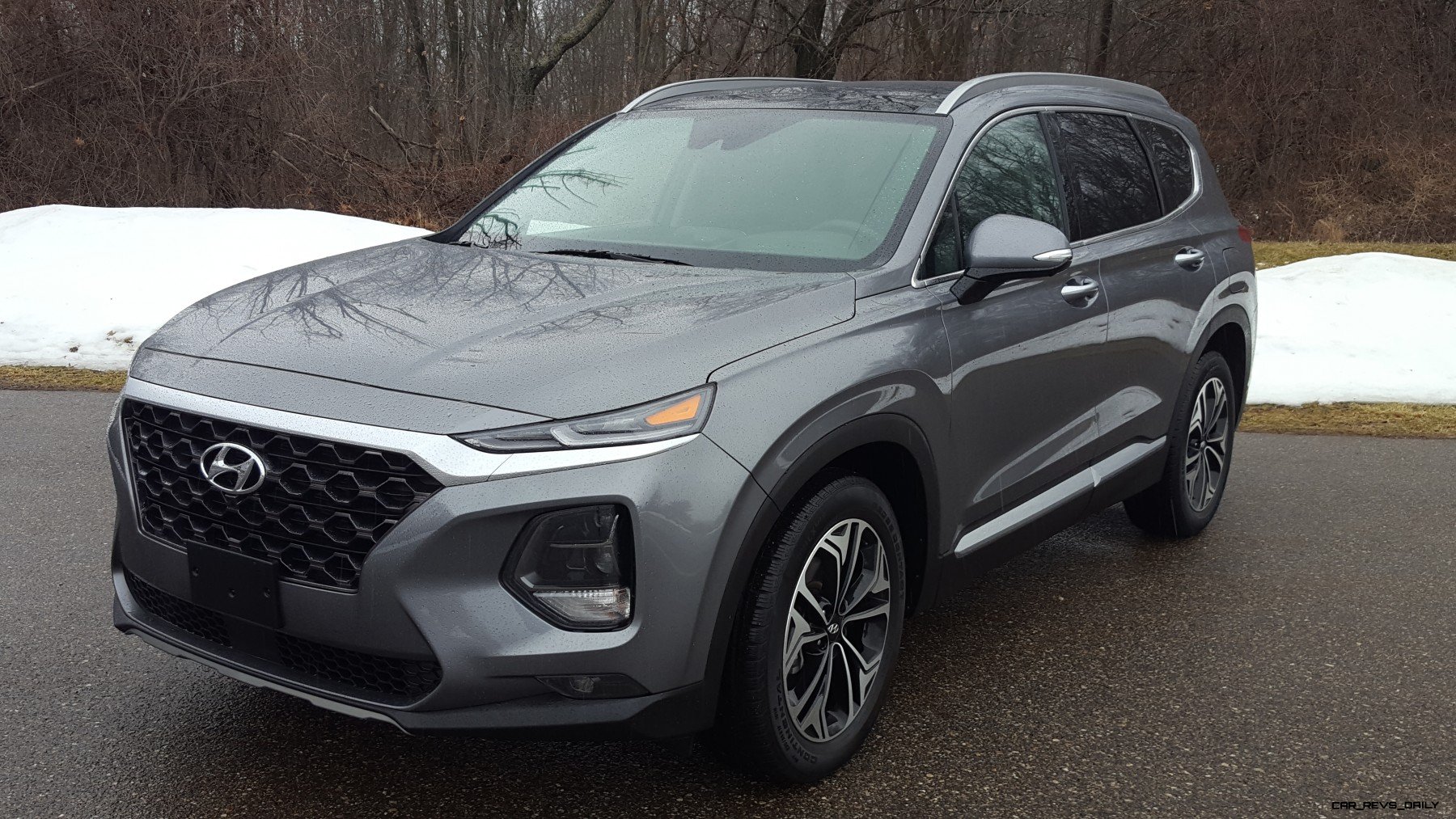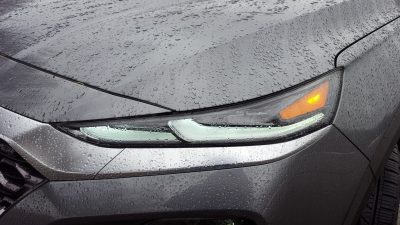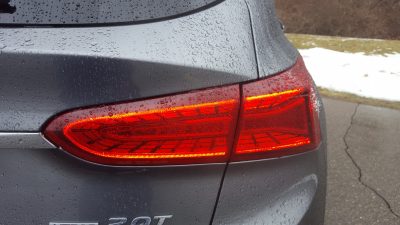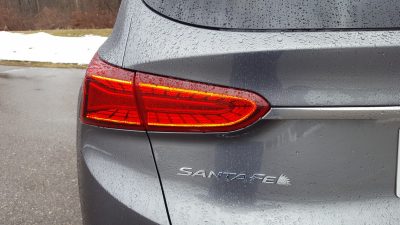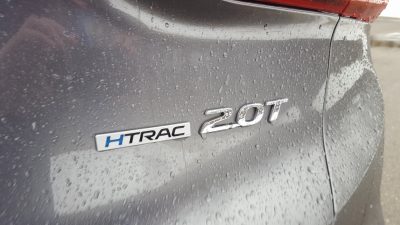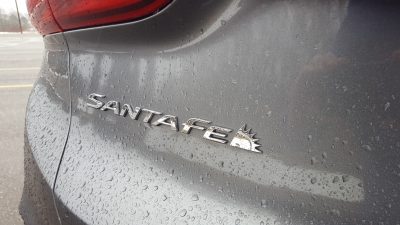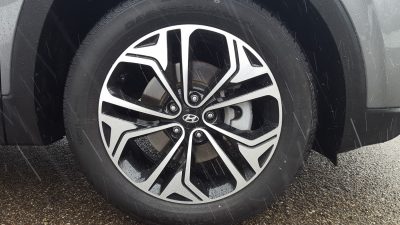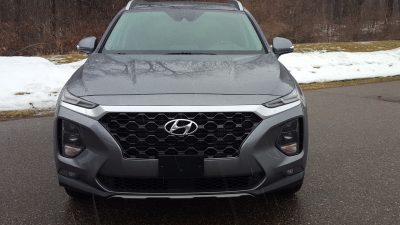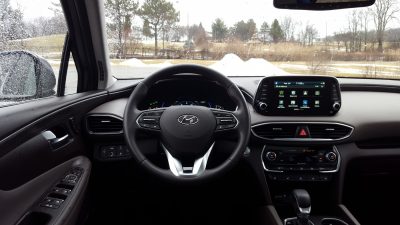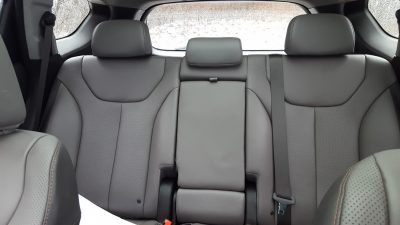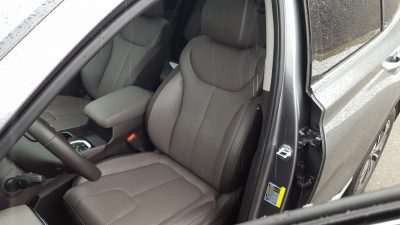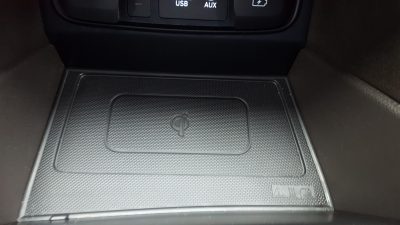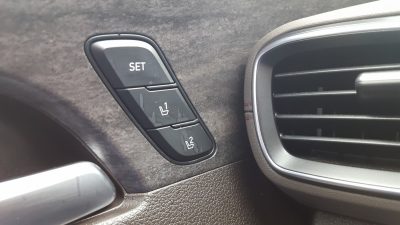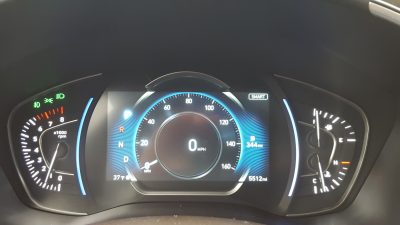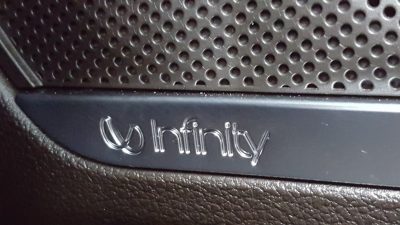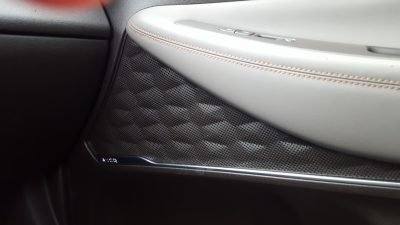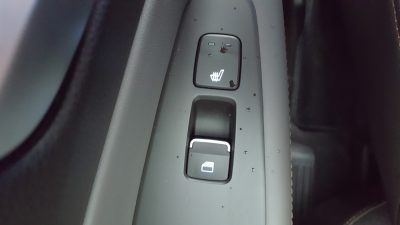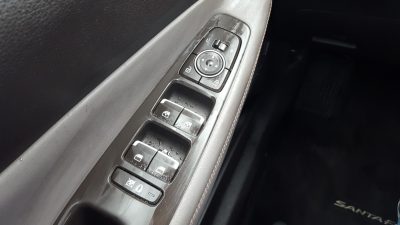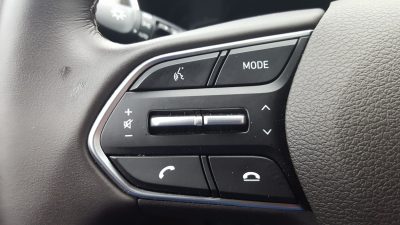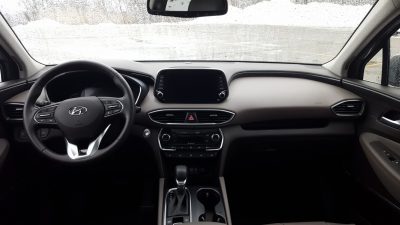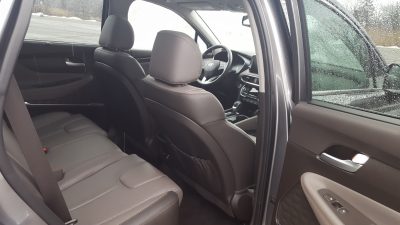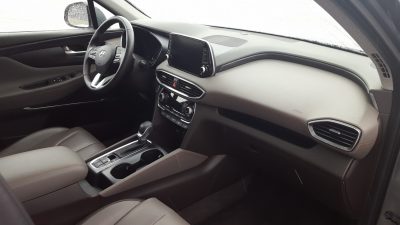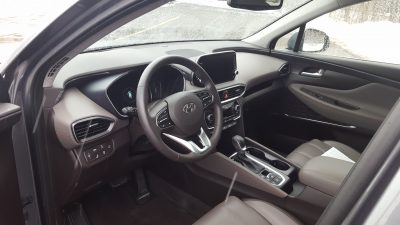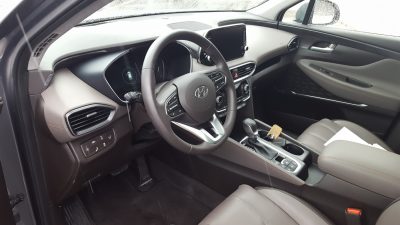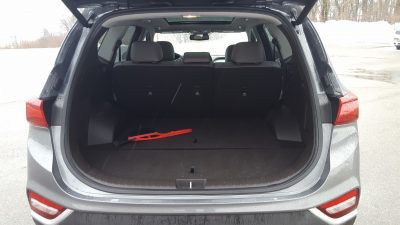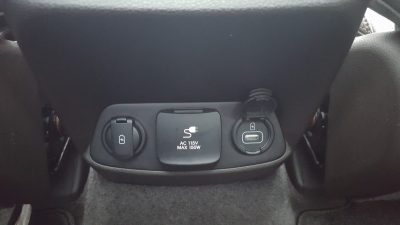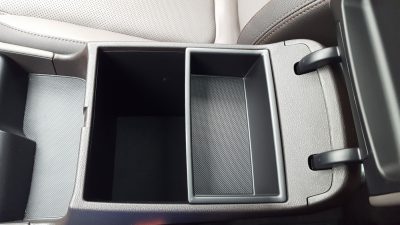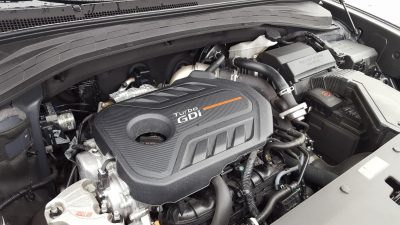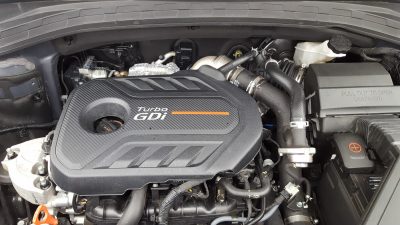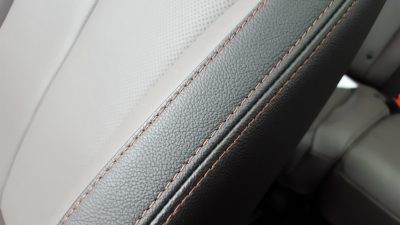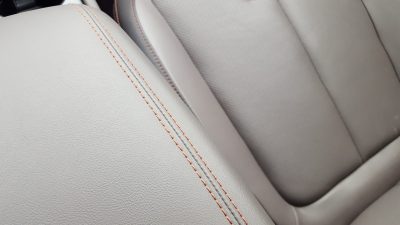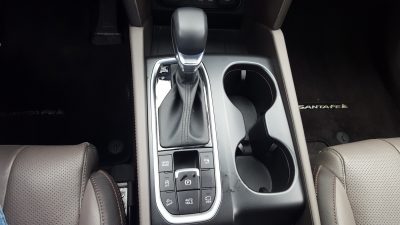When we last met the 2019 Hyundai Santa Fe, it was on its home turf in Alabama, where we had a chance to sample some of the reworked engineering, styling, and performance that went into making this iteration of Santa Fe a true standout in Hyundai’s growing SUV lineup. This time around, we had the opportunity to check out the Santa Fe on the familiar roads that dot our Metro Detroit branch to see if its southern infused charm can translate into a truly capable offering that can bring the best of both worlds to eager SUV buyers.
Functionally Elegant:
It was no secret that the last generation Santa Fe was missing that special something on the aesthetic front, with the SUV falling behind some of its updated rivals in terms of sheer looks. This time around, Hyundai designers opted to go for a far more aggressive suit of clothes. The front fascia is arguably the most noticeable recipient of this newfound confidence thanks to its new grille design, with Hyundai claiming that the new look is called “cascading” and is supposed to mimic the way the company produces steel at its plant in South Korea. While we are still chewing on that explanation, we will admit that it is a noticeable improvement over the old model especially the way the grille compliments the high mounted LED daytime running lights. The headlights themselves are mounted lower in the front bumper, and the end result is a relatively futuristic look with subtle hints of Hyundai Kona in some of its core DNA.
The side profile does not reach out and grab the eye like more sporting fare, but it is a functional look, and we will give props to Hyundai for outfitting our Ultimate grade tester with a slick set of wheels to help inject a bit of personality into this particular area. The rear fascia is adorned with thinner taillights, and the reverse lenses themselves have been moved lower down. These minor changes help make the rear end much more aggressive looking, and it is nice to see the Santa Fe stand out from some of its blander rivals when it comes to rear end design (a rarity in this segment.) With the 2020 Ford Escape promising to bring more European inspired influence into its character, the Santa Fe will have a very formidable contender in this arena, but it will always be a step above the Chevrolet Equinox, Nissan Murano, and the Toyota Rav4 which take a more polarizing approach to their exterior layouts.
A Value Packed Cabin:
The Santa Fe’s focus on achieving a polygonal design theme continues into the radically reworked interior, The polygon designs are especially noticeable in the seat pattern, as well as the door mounted speaker covers for the sound system. This is a very neat design feature, and it does make up somewhat for some of the cheap and hard feeling plastics that are scattered throughout the cabin, especially in the lower portions of the dashboard. We also like the fabric trim that adorns the pillars, ceiling, and the sides of our tester. Unlike other manufacturers which tend to use cheap “mouse fur” for this application, Hyundai’s solution reminded us of an upscale handbag in terms of fabric feel, and its nice to see that even in this minor area, quality does indeed reign supreme.
Buyers will also be pleased with the simple and very straightforward layout that adorns the dashboard. A 7.0 inch touchscreen is standard issue, but opt for the Ultimate trim like our tester, and you are rewarded with an 8.0 inch unit that comes bundled with navigation. Unlike a lot of other infotainment systems on the market, Hyundai retained hard buttons and knobs for some functions such as volume control and climate control and thankfully they are within easy reach of the driver. Ultimate models also come equipped with Hyundai’s 7.0 inch “virtual cluster” with the screen changing color depending on what driving mode is selected (blue for Normal, red for Sport, and green for Eco.) The unit can also display a digital speed readout, or imitate a conventional analog speedometer.
Base models meanwhile, make do with a smaller 3.5 inch screen, as well as traditional gauges. The leather seats that adorned our tester were also very comfortable places to spend time in, with good amounts of lower and upper back support. Head and leg room are also very good, but taller passengers in the second row might find headroom a bit tight. The rear seats also move forward and back, and even come with a recline feature to help improve long distance comfort. With 36 cubic feet of cargo room on hand, our tester proved to be very capable of swallowing a wide range of cargo too, and the low liftover was a big help when it came to loading bulkier items. A hands-free power operated tailgate is standard equipment, and that should help young families that might need both hands to load a weeks worth of groceries, or items for the next family road trip. Santa Fe’s sold in global markets come with a third row that removes 1 cubic foot of space, but with the arrival of the bigger Paliasade SUV, Hyundai opted to keep our version a two-row only offering, which is fine by us.
Confident Performance For All Occasions:
The 2019 Hyundai Santa Fe will never be mistaken for an offering that is catered towards enthusiasts, but we will give Hyundai engineers credit for trying their best to instill more vigor into the Santa Fe’s driving manners. Despite the removal of the Sport moniker from its name for the new model year, our tester still managed to show it had plenty of spunk under the hood. Power for our tester came from the optional 2.0 liter four cylinder engine which also sees duty in a host of other Hyundai and Kia offerings. Good for 235 horsepower, the engine does suffer from a bit of initial turbo lag, but once the turbocharger had a chance to wake up, our tester delivered confident acceleration and the ample amount of low end punch was especially welcome when undertaking freeway passing maneuvers. A base 2.4 liter four cylinder engine is optional, but while 184 horsepower is nothing to sneeze at, we highly recommend getting the boosted four to truly get the best out of the Santa Fe. An eight speed automatic transmission is the sole unit available, and it did a good job quietly rowing its way through the gears with very little gear hunting or delay.
While the 2019 Hyundai Santa Fe has a very long way to go before it can dog-fight performance focused models like the Alfa Rome Stelvio, handling in our tester was very composed, and while our last encounter on Alabama’s silky smooth roads did little to test the revised suspension, this time Michigan’s pot hole infested roads gave it much more of a workout. Many divots and imperfections are smoothed out very nicely, and even rougher sections of tarmac are delightfully muted. This enhances the already impressive feeling of structural solidity, and helps give the Santa Fe the ability to be a formidable road trip companion. Bodyroll is roughly average for a vehicle of its type, and the quicker steering delivered good amounts of feedback save for a big dead spot in the center. The wheel is also decently sized, and falls into your hands very easily. This svelte steering allows the Santa Fe to have the versatility to play two roles at once, that being a sensible family hauler, as well as a very unlikely companion for weekend jaunts down switchbacks. We can only imagine what a sprinkle of “N” branded pixie dust will do to enhance things further, and we look forward to seeing if such a model is indeed in the cards.
Braking in our tester was strong and confident, and while again it will not hold a candle to some spicier SUV entries in the marketplace, many buyers will be pleased with the minimal amounts of nose dive, and the equally minimal amounts of fade we observed during our time with our tester. We will also give props to Hyundai’s excellent adaptive cruise control system for being able to easily cope with all kinds of driving situations, including the chronic bouts of traffic that is common place on Michigan roads for the bulk of the year.
Value Quotient:
Pricing for the 2019 Hyundai Santa Fe reflects Hyundai’s efforts at trying to appeal to a wider range of buyers. Before we go on any further, we might as well address the second Santa Fe in the room, the XL. Once known as the Santa Fe, and part of a two model name swap by Hyundai, this model is currently the only three row U.S. spec Santa Fe variant available. However, it is merely a placeholder, and will leave the lineup once the Palisade formally begins arriving in Hyundai showrooms later this year. As for the Santa Fe itself, pricing starts at $25,750 for the base SE model which comes with a strong amount of standard equipment including Forward Collision Alert, Rear Cross Traffic Alert, Blind Spot monitoring and other driver assist technology. Naturally, climbing up through the trim ladder increases both the price and the standard equipment until you hit the range topping Ultimate trim. Like the Limited, this trim is split in two, the naturally aspirated $35,450 variant, and turbocharged models like our tester, which start at $37,100. Our fully loaded example had a final price of $39,905 which included the $980 destination fee, as well as its lone option, a set of $125 carpeted floor mats.
This pricing ladder is very value centric, but it also exposes a key weakness in regards to equipment packaging. For example, if you want the 2.0 liter turbo four you have to opt for either the Limited or the Ultimate model which puts the engine in the higher pricing bracket, with the three lower models being excluded from the turbo club. In contrast, the Chevrolet Blazer and the Ford Edge offer turbocharged engines in the lower end of their model trees, and the Blazer even offers a more powerful 3.6 liter V6 that makes over 100 horsepower more than the Santa Fe’s turbocharged four cylinder.
Meanwhile, the Honda Passport brings a bit more rough and ready adventurism to the segment, and it manages to use its shrunken Honda Pilot packaging very effectively when it comes to equipment and styling despite being a V6 only offering. The Passport does lose a bit of ground to the Santa Fe when it comes to infotainment technology, and some of its ergonomics fall a tad short of the Hyundai’s.
With a literal arsenal of standard equipment, respectable driving manners, and a renewed focus on safety technology, the 2019 Hyundai Santa Fe aims to claw its way into the upper reaches of the SUV segment with little regard to whatever it dethrones along the way. We think it has a solid chance of doing this feat thanks to the value focused choices that Hyundai engineers made to not only enhance value, but also enhance the Santa Fe’s interior ambiance. We look forward to seeing if the Santa Fe can help be a vital cog to Hyundai’s plans to rapidly increase its SUV business. With the model sharing space with two other key models (the recently unveiled Venue and flagship Palisade) we are confident that things will continue to look bright for Hyundai’s SUV ambitions.

Carl Malek has been an automotive journalist for over 10 years. First starting out as a freelance photographer before making the transition to writing during college, his work has appeared on numerous automotive forums as well as websites such as Autoshopper.com.
Carl is also a big fan of British vehicles with the bulk of his devotion going to the Morgan Motor Company as well as offerings from Lotus, MG, and Caterham. When he is not writing about automobiles, Carl enjoys spending time with his family and friends in the Metro Detroit area, as well as spending time with his adorable pets.

